
Tiny Home Regulations in Ohio: The Complete Guide
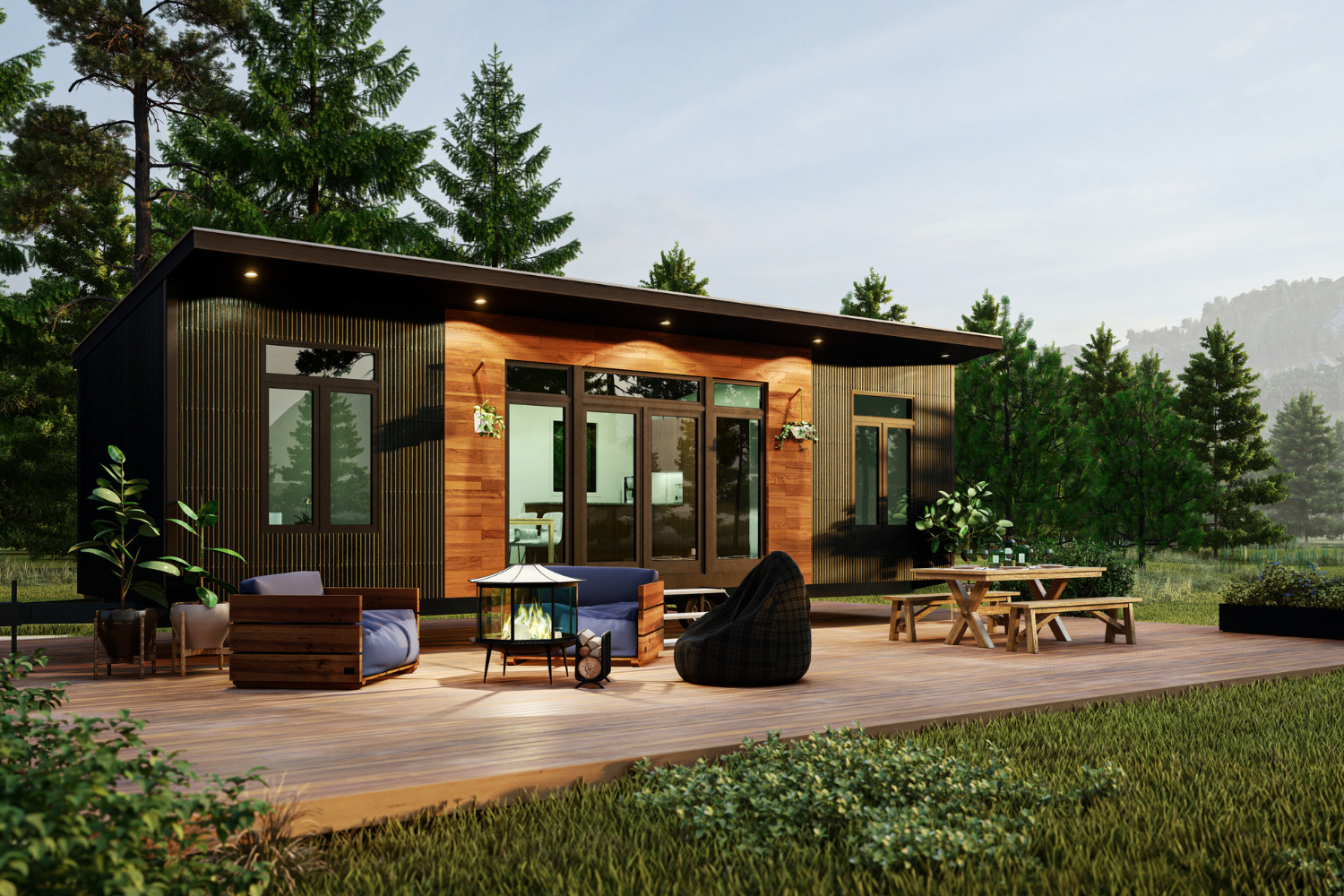
There are many reasons to go tiny in Ohio. As a quintessential Midwestern State, Ohio offers much in the way of nature, culture, and big-city living. Tiny homes in Ohio are a way to experience all that Ohio has to offer. Tiny living provides a unique, fun, affordable, and sustainable way to own a home in Ohio.
As more people explore tiny living in Ohio, many important questions come up! You might be asking yourself…
- Can I legally live in a tiny home in Ohio?
- Does Ohio have tiny home communities?
- What are the zoning laws for tiny houses in Ohio?
- Are there tiny home builders in Ohio?
Here at Zook Cabins, we are passionate about tiny living and eager to answer your questions. This article will walk you through your many questions and guide you through everything you need to know about tiny house living in Ohio! .
Are Tiny Homes Legal In Ohio?
Yes! Tiny homes are legal in the state of Ohio.
However, Ohio’s building code requires that any permanent home have a living area of 950 square feet or more. This is much larger than most tiny homes, making tiny living somewhat of a complex issue in the state of Ohio. Essentially, if a house is built on a permanent foundation, it must comply with Ohio’s residential building code. This means the living area must be 950 sq ft or larger, and the home must meet plumbing, electrical, and insulation standards.
Tiny homes on wheels are permitted in Ohio and are typically classified as “non-self-propelled RVs.” Classifying tiny houses on wheels as recreational vehicles means that tiny homes on wheels are not considered permanent dwellings and are restricted to RV parks and campgrounds in most Ohio counties. Accessory dwelling units, or ADUs, are only zoned for human occupancy in some but not all counties in Ohio.
To sum up, in most cases, a tiny home in Ohio must be 950 sq ft or on wheels! However, checking with your local county or city zoning department is always best to ensure your next building project complies with all laws!
What Counties in Ohio Allow Tiny Homes?
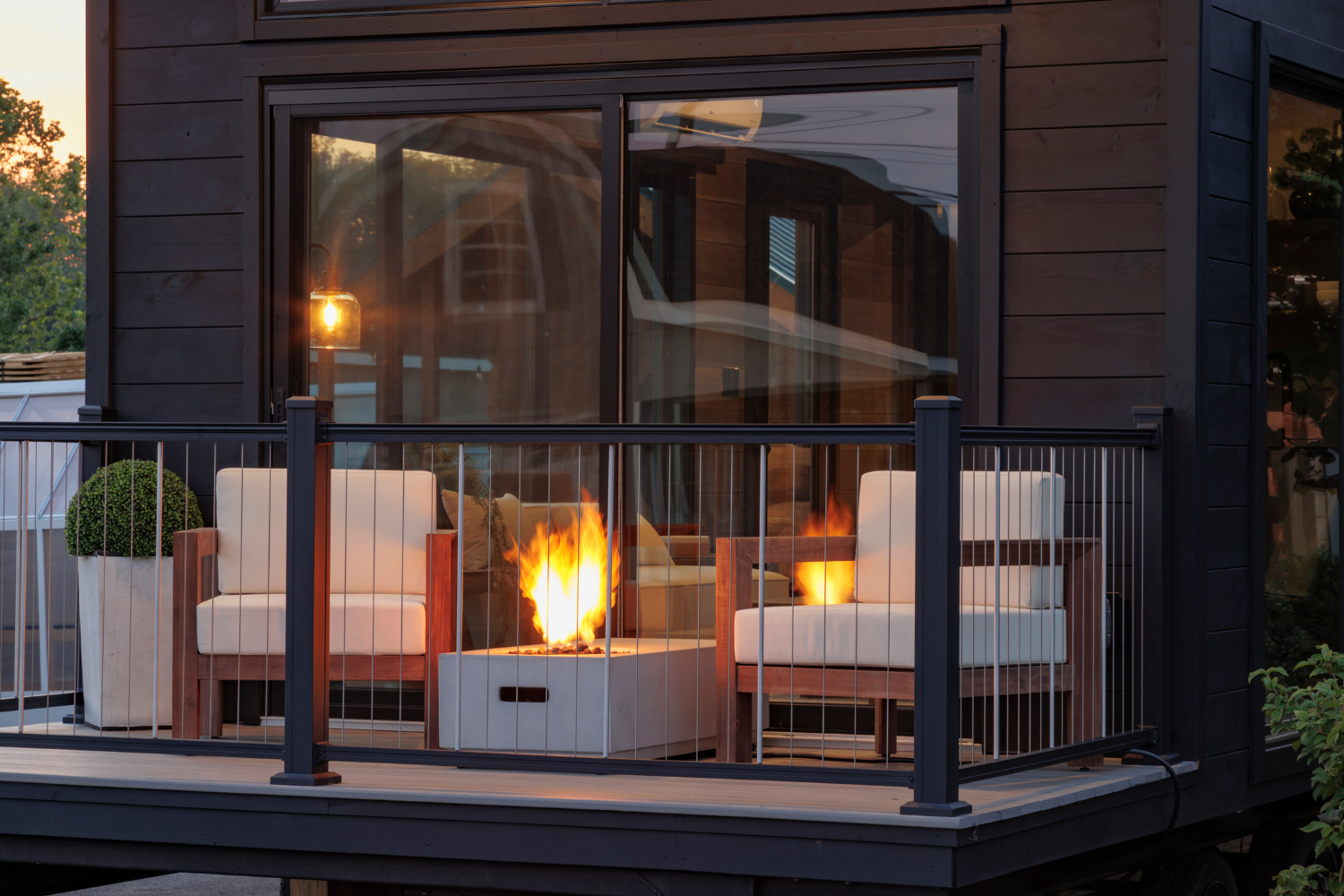
Lucky for tiny home enthusiasts, tiny houses are legal in Ohio. However, tiny home regulations in Ohio vary by county, city, township, and village. Many counties and cities in Ohio have different floor area requirements for permanent homes. Additionally, each zoning area has its own requirements. Check your county’s zoning regulations using the table below!
Are park models and tiny homes the same thing?
Yes. All of the park model tiny homes that Zook Cabins would be classified as a THOWs. Built to ASNI 119.5 these cabins are built to RV standards. however, other tiny homes may be built to NOAH standards. You can learn about the differences in our blog RVIA Vs NOAH Tiny Homes.
Find Your Tiny Home Regulations in Ohio By County
Does Adams County, OH Allow Tiny Homes?
Yes, Adams County, Ohio, follows the tiny home regulations in Ohio. This means that any permanent house must be built on a foundation, attached to the appropriate utilities, and have a minimum floor area of 950 sq ft. Tiny homes on wheels are not considered permanent residences. They are allowed in mobile home parks with appropriate skirting, RV parks, or campgrounds. Accessory structures are prohibited for use as housing in Adams County. Be sure to check your most local city or town’s ordinances for the most relevant rules for your next tiny home!
Does Allen County, OH Allow Tiny Homes?
Yes. Allen County, Ohio, does allow tiny homes. Allen County generally follows Ohio’s statewide tiny home regulations and building code. Additionally, Allen County permits the use of accessory dwellings as residences in both agricultural and residential districts. Some areas in Allen County classify tiny homes and tiny homes on wheels as mobile homes and only permit them in mobile home parks. Check local building and zoning codes to know how best to build and place your tiny home!
Does Ashland County, OH Allow Tiny Homes?
Ashland County, Ohio, does allow tiny homes. Tiny homes on wheels are permitted in Ashland County inside RV parks and campgrounds. Additionally, Ashland County permits the use of accessory buildings for human occupancy so long as there are no kitchen facilities inside the residence. Check your local city or town ordinances for the most complete list of regulations for your Ashland County tiny house.
Does Ashtabula County, OH Allow Tiny Homes?
Yes! Ashtabula County, Ohio, follows Ohio’s building code and permits tiny houses with a living area of 950 sq ft or greater. Tiny homes on wheels are permitted in RV parks or campgrounds. However, Ashtabula County does not allow accessory buildings to be used for human occupation and does not permit mobile home trailers as accessory buildings. Check your local town ordinances to ensure your tiny home is up to code!
Does Athens County, OH Allow Tiny Homes?
Yes, Athens County, Ohio, allows tiny homes with specific specifications. Each permanent home should have one toilet, lavatory basin, and bathtub or shower connected to an approved water and sewer system with hot and cold water. Additionally, the kitchen inside the home should have a minimum floor area of 50 sq ft. Overall, the home should have a minimum floor area of 140 sq ft per occupant, with 70 sq ft added for each additional occupant. Lastly, if the tiny home is on wheels, the maximum width for the home is 102 inches to comply with driving regulations.
This might seem like a lot, but it’s good for tiny home builders in Ohio and for you! This means that a tiny home in Athens County can be smaller than the statewide regulation for permanent residence floor area. Always check local laws to ensure your tiny home meets your area’s specifications.
Does Auglaize County, OH Allow Tiny Homes?
Yes. Auglaize County does permit tiny homes. However, Auglaize County zones by independent townships. Check the list of zoning codes for your specific township here! If the township code does not specify building regulations for tiny homes or other permanent residences, then that means it follows the statewide tiny home regulations in Ohio or the Ohio building code.
Does Belmont County, OH Allow Tiny Homes?
Belmont County, Ohio, does allow tiny homes. There are no specific tiny home zoning regulations in Belmont County. Therefore, each city or village has the right to determine its own regulations for tiny homes. Otherwise, Belmont County follows Ohio’s tiny home regulations and building code. Check your local city or village’s laws regarding building and zoning codes before you begin tiny living in Belmont County, Ohio.
Does Brown County, OH Allow Tiny Homes?
Yes! Brown County, Ohio, does permit tiny homes. Brown County follows Ohio’s statewide tiny home laws. This means that tiny homes must have a minimum livable floor area of 950 sq ft and that tiny homes on wheels are classified as recreational vehicles (RVs) and are permitted at RV parks and campgrounds. To determine the specific rules that will affect your tiny home, consult Brown County zoning authorities and your local city regulations.
Does Butler County, OH Allow Tiny Homes?
Yes, Butler County, Ohio, follows statewide tiny house regulations in Ohio and the Ohio building code. Additionally, the Butler County code states that accessory buildings may not be used as residential dwellings and restricts the use of manufactured homes for residential use except when the manufactured home is placed in a manufactured home or mobile home park. Check local ordinances for the most complete list of tiny home regulations in Butler County.
Does Hamilton, OH Allow Tiny Homes?
Yes. Hamilton City, Ohio, does allow tiny homes. Like Butler County, Hamilton follows Ohio’s building code and allows tiny homes with a minimum floor area of 950 sq ft. Because Hamilton City is one of Ohio’s largest cities, it is important to check with your local regulations to determine the best place to place or build your tiny home.
Does Carroll County, OH Allow Tiny Homes?
Carroll County, Ohio, does allow tiny homes. Carroll County does not have explicit or widely published regulations regarding tiny homes. The best bet is to follow Ohio’s building code and check with local township and city building and zoning codes.
Does Champaign County, OH Allow Tiny Homes?
Yes! Champaign County, Ohio does allow tiny homes. A permit is required to build or place a home in Champaign County, Ohio. Additionally, Champaign County has a slightly stricter minimum floor requirement than the rest of Ohio. Champaign County requires individual manufactured or mobile homes to have a minimum floor area of 1,200 sq ft. This is much larger than the average tiny home (225 sq ft) but still smaller than the average American single-family home (2,260 sq ft). Check your local laws to ensure compliance!
Does Clark County, OH Allow Tiny Homes?
Yes, Clark County, Ohio, does allow tiny homes. Clark County requires permits for the building, placing, and driving of tiny houses. Clark County also permits the use of accessory buildings as human residences. Otherwise, Clark County follows Ohio’s building code and the corresponding tiny home regulations in Ohio. Check local city and town ordinances for the most accurate rules for your next tiny home!
Does Clermont County, OH Allow Tiny Homes?
Clermont County, Ohio, does allow tiny homes. A permit is required for all manufactured homes and for auxiliary buildings. Clermont County also has a limiting minimum floor area requirement of 1200 sq ft, but that number can include the floor area of attached garages and finished basements. Allowing tiny home enthusiasts in Ohio some flexibility. Additionally, zoning and permit requirements may differ by individual township, so always be sure to check your local laws.
Does Clinton County, OH Allow Tiny Homes?
Yes! Clinton County, Ohio, does allow tiny homes. Clinton County follows Ohio’s tiny home laws and the Ohio building code. This means all permanent homes must be on a foundation and have a total floor area of not smaller than 950 sq ft. Check local city and township zoning to determine local tiny home regulations.
Does Columbiana County, OH Allow Tiny Homes?
Yes, Columbiana County, Ohio, does allow tiny homes and has more friendly regulations than most counties in Ohio. Columbiana County permits permanent dwellings with a minimum floor area of 650 sq ft. Columbiana County has even fewer restrictions for accessory buildings as well. Check local zoning to ensure your tiny home in Columbiana County complies with all tiny house laws!
Does Coshocton County, OH Allow Tiny Homes?
Yes. Coshocton County, Ohio, does allow tiny homes. A permit is required in Coshocton County for all tiny homes. Coshocton County follows Ohio’s building code and requires permanent dwellings to have a minimum floor area of 950 sq ft and for tiny houses on wheels to be placed in the appropriate mobile home, RV, or campground park. It’s best to check with your local building department to find out the acceptable regulations for your tiny house.
Does Crawford County, OH Allow Tiny Homes?
Crawford County, Ohio, does allow tiny homes. Crawford County does not have a clear countywide code that addresses tiny homes. This means that Crawford County likely follows the statewide regulations for residences and the Ohio building code. However, it is important to also check local zoning laws and building codes as they can vary widely between towns.
Does Cuyahoga County, OH Allow Tiny Homes?
Yes, Cuyahoga County, OH, allows tiny houses. Accessory housing units are widely permitted in Cuyahoga County for human residency, especially as a second residence. It is important to note that cities in Cuyahoga are independently zoned, which means that tiny house laws differ from town to town in Cuyahoga. It is best practice to check your most local tiny home regulations to ensure your tiny home is up to code!
Does Cleveland, OH Allow Tiny Homes?
Yes. Cleveland, Ohio, typically follows the state’s regulations regarding permanent homes, meaning that residential homes must have a minimum of 950 sq ft of living space. A permit is also required to build or place a tiny house in Cleveland. Because Cleveland is a major city, always double-check your tiny home regulations as they change in response to people’s needs.
Does Darke County, OH Allow Tiny Homes?
Yes, Darke County, Ohio, does allow tiny homes. Darke County does not have specific regulations for tiny homes and thus follows Ohio’s tiny house regulations. Remember that some areas within the county may have slightly different requirements, so always consult local building codes before building!
Does Defiance County, OH Allow Tiny Homes?
Yes! Defiance County, Ohio, does allow tiny homes! Defiance County has specific regulations for floor areas in various home types. For permanent homes in residential zones, a minimum floor area of 900 sq ft is required; in agricultural zones, permanent dwellings must have 1100 sq ft of floor area. For mobile homes inside a mobile home park, a minimum floor area of 600 sq ft is required, while a mobile home located outside a mobile home park must have a floor area of at least 1100 sq ft. Check your local town’s zoning code to determine how your tiny home is defined in your area and the specific requirements for it!
Does Delaware County, OH Allow Tiny Homes?
Yes. Tiny homes in Delaware County are legal. Delaware County only requires a minimum floor area of 320 sq ft for tiny houses on wheels, allowing tiny home builders more flexibility in Delaware County than in other counties in Ohio. However, accessory structures in Delaware County are not permitted for human residency. Permanent home regulations follow Ohio’s building code. They must be on a foundation, attached to appropriate utilities, and at least 950 sq ft. Check your local town and city codes and regulations to determine the most specific rules for you!
Does Erie County, OH Allow Tiny Homes?
Yes, tiny homes are legal in Erie County, Ohio. Erie County zones by city, which means it is best practice to check your local city’s regulations for tiny houses. You can find a list of cities in Erie County and their zoning codes here. If the city you are looking for does not specify regulations for tiny homes, that means the city follows the statewide zoning and building code.
Does Fairfield County, OH Allow Tiny Homes?
Yes! Fairfield County, Ohio, does allow tiny homes. Fairfield County does not have county-wide zoning. Instead, zoning regulations are adopted by individual townships, cities, and villages. Check out each location’s regulations here!
Does Fayette County, OH Allow Tiny Homes?
Fayette County, Ohio, typically allows tiny homes. Fayette County requires a permit for all building and placing of tiny homes. Fayette County also regulates that mobile homes and tiny homes on wheels must have a floor area of 320 sq ft or more. Fayette County accepts permanent tiny homes, those not on wheels, on a case-by-case basis. Ensure you always check your local city or town regulations and provide all the appropriate information in your permit application to get your tiny home approved!
Does Franklin County, OH Allow Tiny Homes?
Yes, Franklin County does allow tiny homes, but only if the tiny home is built on a trailer and is between 60-400 square feet. If the tiny house is not built on a trailer, it is classified as a mobile home and can be a minimum of 450 square feet of heated and cooled space. Otherwise, tiny houses built on permanent structures must be fixed to a permanent foundation, have a total living area of at least 900 sq ft, and be attached to the appropriate utilities.
Does Columbus, OH Allow Tiny Homes?
Yes, Columbus, Ohio, in most cases, does allow tiny homes. Columbus has somewhat conflicting regulations regarding tiny homes. ADUs are permitted in Columbus. However, tiny homes can not be classified as permanent residences under the city’s zoning regulations unless they have a living area of 950 sq ft or larger. Tiny homes are allowed for temporary residences or are permitted in RV parks if they are on wheels. If you are interested in modern tiny living in Columbus, OH, be sure to check the most recent zoning laws to ensure your next tiny home is up to code!
Does Fulton County, OH Allow Tiny Homes?
Yes, Fulton County, Ohio, does allow tiny homes. Fulton County requires the application of a permit for all building projects. Specific regulations for homes, like zoning and floor area requirements, frequently vary by township, but Fulton County typically requires all permanent dwellings to have a minimum square footage of 1000 sq ft. This is somewhat restrictive for tiny home builders in Ohio as tiny homes are usually much smaller than 100 sq ft. Be sure to check with your local township to ensure your tiny home meets the appropriate requirements.
Does Gallia County, OH Allow Tiny Homes?
Yes. Gallia County, Ohio, does allow tiny homes. Gallia County zones by individual city or town, so you must check your local city or town to determine the specific regulations you should meet for your next tiny home.
Does Geauga County, OH Allow Tiny Homes?
Yes! Geauga County, Ohio, does allow tiny homes. Geauga County follows Ohio’s state regulations for tiny houses. This means permanent structures must be 950 sq ft or greater and be attached to all appropriate utilities. This also means that any home smaller than 950 sq ft is not considered a permanent structure, must be on wheels, and must be located in the appropriate mobile home, RV, or campground park.
Does Greene County, OH Allow Tiny Homes?
Greene County, Ohio, does allow tiny homes as Greene County follows the 2024 Ohio Building Code and the 2019 Residential Code of Ohio for 1, 2, and 3-family dwellings. Always check Ohio’s state-wide tiny home regulations and your local town or city regulations to ensure your tiny home is up to code.
Does Guernsey County, OH Allow Tiny Homes?
Yes, Guernsey County, Ohio, does allow tiny homes. A permit is required in Guernsey County to build or place a tiny house. Otherwise, Guernsey follows tiny home regulations in Ohio, which require permanent structures to have a minimum floor area of 950 sq ft or be classified as recreational vehicles. Be sure to check your local zoning and building regulations before building or buying a tiny home in Guernsey County!
Does Hamilton County, OH Allow Tiny Homes?
Hamilton County, Ohio, does allow tiny homes! Zoning restrictions in Hamilton County regulate tiny houses on wheels as temporary dwellings and, therefore, require that they be in RV parks and campgrounds. Additionally, park models must be registered with the Hamilton County DMV before being permitted on the road. Hamilton County does permit accessory dwelling units as residences, and some cities in Hamilton County, like Cincinnati, have less restrictive minimum floor area requirements than Hamilton County’s 950 sq ft. Check your local city’s requirements while planning for your next tiny home!
Does Cincinnati, OH Allow Tiny Homes?
Yes! Cincinnati does permit tiny homes. Accessory dwelling units are allowed in Cincinnati, provided they contain permanent utility hookups. Otherwise, any home on its own property must follow state regulations. Because Cincinnati is a highly populated city, laws are constantly changing to accommodate the growing population. Check the most recent regulations to ensure your tiny home’s complete compliance.
Does Hancock County, OH Allow Tiny Homes?
Yes, Hancock County, Ohio, does allow tiny homes. Generally, Hancock County follows state regulations regarding tiny home regulations. However, Hancock County permits the use of accessory buildings as permanent dwellings. Hancock County also requires the special registration of manufactured homes with the county for tax purposes. Regulations may vary between cities or towns, so it’s best to check your local planning and zoning offices for the most accurate rules for your area.
Does Hardin County, OH Allow Tiny Homes?
Yes! Hardin County, Ohio, does allow tiny homes. Hardin County has slightly more flexible floor area requirements than the state of Ohio, which requires that permanent family dwellings have a minimum floor area of 800 sq ft and that mobile homes have a minimum floor area of 600 sq ft. Additionally, Hardin County permits accessory buildings as residences in agricultural-zoned areas. Check your local zoning office for the most accurate list of regulations for your next tiny home.
Does Harrison County, OH Allow Tiny Homes?
Yes, Harrison County, Ohio, does allow tiny homes. Harrison County stipulates that the minimum livable floor area shall be no smaller than 720 sq ft. Harrison County zones by townships, so always check your local area regulations. View this list of zoning contact information for townships in Harrison County.
Does Henry County, OH Allow Tiny Homes?
Henry County, Ohio, does allow tiny homes. Henry County requires permanent structures to have a minimum floor area of 900 sq ft. Also, manufactured homes must be attached to a permanent frost-free foundation and all appropriate facilities or be classified as recreational vehicles. Check your local town or city regulations to ensure your tiny home is up to code.
Does Highland County, OH Allow Tiny Homes?
Yes, Highland County follows Ohio’s tiny home regulations and permits tiny homes. Highland County enforces residential buildings under the 2019 Residential Code of Ohio. This means that all permanent structures must be 950 sq ft or greater and be attached to the appropriate foundation and utilities. Any tiny home on wheels or smaller than 950 sq ft is not considered a permanent residence and must reside in a mobile home or RV park. Check your local area’s zoning office for the most accurate information.
Does Hocking County, OH Allow Tiny Homes?
Hocking County, Ohio, does allow tiny homes. Hocking County requires a permit for the building or placing of tiny houses. Hocking County follows tiny homes regulations in Ohio. Check Ohio’s building code and your local area’s zoning department for the most up-to-date rules for your tiny home.
Does Holmes County, OH Allow Tiny Homes?
Yes! Holmes County, Ohio, does allow tiny homes. Holmes County likely follows Ohio’s statewide tiny home laws. However, it is best practice to check the county’s zoning and building regulations. Holmes County zoning and building code information is available to view in the zoning office at 2 Court Street, Millersburg, OH, inside the Old Jail Office Building.
Does Huron County, OH Allow Tiny Homes?
Huron County, Ohio, does allow tiny homes. A permit is required in Huron County for the building and placing of any structure. Huron County follows Ohio’s tiny home regulations, which regulate permanent structures to have a minimum floor area of 950 sq ft or be on wheels and placed in mobile homes or RV parks. Check your local area’s zoning and building code to ensure your tiny home meets your local requirements.
Does Jackson County, OH Allow Tiny Homes?
Jackson County, Ohio, does permit tiny homes. Jackson County follows Ohio’s statewide building and zoning regulations, which require permanent dwellings to have a minimum floor area of 950 sq ft. Check with your local building or zoning departments to ensure you are following your area’s tiny home laws!
Does Jefferson County, OH Allow Tiny Homes?
Yes, Jefferson County, Ohio, does allow tiny homes. A permit is required in Jefferson County to build or place a tiny house. Otherwise, Jefferson County follows tiny home regulations for the state of Ohio. It is best practice to check your local zoning code before beginning your next tiny home project.
Does Knox County, OH Allow Tiny Homes?
Knox County, Ohio, does permit tiny homes. However, Knox County has slightly more strict requirements for permanent structures than the state of Ohio’s regulations. Knox County requires the minimum floor area for residential buildings to be 1000 sq ft with a full basement or 1250 sq ft without a full basement.
This is much larger than the average tiny home size but still smaller than the average American single-family home. Check your local building regulations for the most up-to-date information for your next tiny home.
Does Lake County, OH Allow Tiny Homes?
Lake County, Ohio, has one of the more strict tiny home regulations in Ohio. Like the rest of the state, tiny homes on wheels are permitted in the appropriate mobile home or RV park, provided they follow all recreational vehicle or mobile home regulations.
However, permanent homes in Lake County must have at least 1,400 sq feet of liveable space for a single-floor dwelling or, for a two-floor dwelling, 1,600 sq ft. Accessory buildings in Lake County, Ohio, are not permitted as living spaces.
Therefore, tiny home enthusiasts looking at Lake County must check with their local city or town to ensure their tiny homes’ legality in Lake County.
Does Lawrence County, OH Allow Tiny Homes?
Yes, Lawrence County, Ohio, does allow tiny homes. Lawrence County specifies that permanent residencies must be a minimum of 1200 sq ft. Check your most local zoning or building departments for specific-to-you tiny home regulations.
Does Licking County, OH Allow Tiny Homes?
Yes! Licking County, Ohio, does permit tiny homes. Licking County has slightly less strict regulations for tiny homes than the state of Ohio. Tiny Homes in Licking County must have a minimum floor area of 700 sq ft with a basement or a minimum of 800 sq ft without a basement. It is always best to check your local town or city laws while building or placing your tiny home in Licking County.
Does Logan County, OH Allow Tiny Homes?
Logan County, Ohio, does allow tiny homes. Logan County requires a permit for the building and placing of all homes. Tiny houses in Logan County should follow Ohio’s state regulations regarding permanent structures and residences. Keep in mind that some parts of the county might have different zoning regulations for tiny homes; always check with your local building and zoning regulations.
Does Lorain County, OH Allow Tiny Homes?
Yes! Lorain County, Ohio, does allow tiny homes. Lorain County requires that a residence be no smaller than 750 sq ft or 900 sq ft for a two-bedroom. Accessory buildings are also conditionally allowed in residential zones in Lorain County. Approval for accessory buildings must be granted by the planning commission. Check with your local building and zoning office for the complete list of regulations for your tiny home.
Does Lucas County, OH Allow Tiny Homes?
Yes! Lucas County, Ohio, does allow tiny homes. Lucas County only requires that permanent dwelling units be at least 150 sq ft for one resident and an additional 130 sq ft for every following resident. Permanent homes must be on a foundation and have all appropriate utility hookups. Additionally, all structures must conform to lot lines, and any home must have at least 4-50 ft of frontage. Lastly, Lucas County requires building permits for structures over 200 sq ft. Check with your local town regulations to ensure your tiny home meets each specification.
Does Madison County, OH Allow Tiny Homes?
Yes. Madison County, Ohio, does permit tiny homes. Manufactured and mobile homes must have a minimum floor area of 800 sq ft with an additional 100 sq ft for every added bedroom. Accessory buildings that are located on the same lot as a primary residence are allowed in Madison County for human occupation. Check your local city or town ordinances for the most specific tiny home regulations for your tiny home.
Does Mahoning County, OH Allow Tiny Homes?
Tiny homes are legal in Mahoning County, Ohio. A permit is required for tiny houses in Mahoning County. Mahoning County regulates that accessory dwelling units should be at most 750 sq ft. Otherwise, Mahoning County zones by township, meaning that each area could have different building expectations. Be sure to always check your local planning commission before building your tiny home in Mahoning County.
Does Marion County, OH Allow Tiny Homes?
Marion County, Ohio, does permit tiny homes. Marion County specifies that mobile and manufactured homes must be placed in a mobile home park to be considered dwellings. Mobile homes used as dwellings must have a floor area of 575 sq ft or larger. Otherwise, they can be placed in residential districts and considered single-family dwellings if they are attached to a permanent foundation, they are bigger than 900 sq ft, and their hitches, axles, and wheels are removed.
Does Medina County, OH Allow Tiny Homes?
Medina County, Ohio, does allow tiny homes. Medina County permits mobile and manufactured homes as residences only if they are located in mobile home parks, campgrounds, or RV parks. Permanent residences must have a minimum floor area for a one-bedroom dwelling of 700 sq ft. A two-bedroom dwelling must be a minimum of 850 sq ft. Check your local city or town building and zoning code to find the most up-to-date tiny home regulations in your part of Medina County, Ohio.
Does Meigs County, OH Allow Tiny Homes?
Meigs County, Ohio, follows tiny home regulations in Ohio and permits tiny homes with a minimum floor area of 950 sq ft. Any tiny house on wheels or structure smaller than 950 sq ft is not considered a permanent residence and must be located in a mobile home park, campground, or RV park. Be sure to check with your most local city or town building and zoning office to find the most accurate regulations for your tiny home.
Does Mercer County, OH Allow Tiny Homes?
Yes. Mercer County, Ohio, does allow tiny homes. Mercer County requires all dwellings to have at least 900 sq ft of liveable floor area. Check your local city or town regulations for additional expectations for your tiny home.
Does Monroe County, OH Allow Tiny Homes?
Monroe County, Ohio, follows the tiny home regulations in Ohio and thus permits tiny homes either on wheels and in the appropriate mobile home or RV park or permanent homes with a minimum floor area of 950 sq ft. It is best practice to also check your local city or town planning commission to ensure your tiny house in Monroe County follows local zoning and building codes.
Does Montgomery County, OH Allow Tiny Homes?
Yes, Montgomery County, Ohio, follows Ohio’s statewide tiny home regulations and residential and building codes. This means that permanent structures in Montgomery County must be no smaller than 950 sq ft or be on wheels and located in a mobile home or RV park. Be sure to check your local town or city’s building and zoning code to make sure your tiny house is up to scratch!
Does Dayton, OH Allow Tiny Homes?
Much like the rest of Montgomery County, Dayton, OH, follows the 2019 Residential Code of Ohio, which stipulates that tiny homes are permitted so long as they have 950 sq ft of living area or more.
Does Morgan County, OH Allow Tiny Homes?
Yes. Morgan County does allow tiny homes. Zoning and building regulations are decided by villages in Morgan County. Be sure to check your village’s building regulations to ensure your tiny house is legal in your town. If your village does not have specifications for tiny homes, it is a safe bet to stick to Ohio’s state regulations regarding permanent structures.
Does Morrow County, OH Allow Tiny Homes?
Morrow County, Ohio, does allow tiny homes. A permit is required to build or place a tiny house in Morrow County. Additionally, Morrow County regulates that mobile homes, manufactured homes, and permanent dwellings should have a minimum floor area of 1100 sq ft when built or placed in a residential zoning district. Skirting should also be placed around the perimeter, and the home should be connected to approved septic and water systems.
Does Muskingum County, OH Allow Tiny Homes?
Yes, Muskingum County, Ohio, does allow tiny homes. The county follows Ohio’s building code so that all homes meet construction and safety standards. Permanent homes must adhere to this code, be on a foundation, and have appropriate utility connections. Additionally, Muskingum County requires building permits for all residential structures. Always check with your local zoning and building department to ensure compliance with specific regulations in your area.
Does Noble County, OH Allow Tiny Homes?
Yes, Noble County, Ohio, permits tiny homes. However, zoning and building regulations vary by township within the county. Each town has its own specific guidelines regarding tiny houses, so it’s important to consult with the local zoning and building authorities to ensure your tiny home meets your area’s code.
Does Ottawa County, OH Allow Tiny Homes?
Yes, Ottawa County, Ohio, does allow tiny homes. According to the county’s zoning resolution, permanent residences must have a minimum floor area of 576 sq ft. Additionally, accessory buildings are not permitted for residential use. If you plan to build a tiny home, ensure it meets the minimum size requirements, and always check with your local zoning code to confirm the most up-to-date tiny home regulations in Ottawa County.
Does Paulding County, OH Allow Tiny Homes?
Yes, Paulding County, Ohio, permits tiny homes. Paulding County code mandates that dwellings without a basement must have a minimum floor area of 1,000 sq ft. Be sure to check with the local zoning office for any additional requirements or restrictions in your area before you buy a tiny house.
Does Perry County, OH Allow Tiny Homes?
Yes, Perry County, Ohio, allows tiny homes under certain conditions. Perry County code specifies that mobile homes and recreational vehicles must have a minimum of 600 sq ft of livable space and be located within a mobile home or RV park. Permanent residences in residential districts should have a total minimum livable floor area of 900 sq ft without a basement or 850 sq ft with a basement. Always verify with your local town’s zoning office to ensure your tiny home complies with all local regulations!
Does Pickaway County, OH Allow Tiny Homes?
Yes. Pickaway County, Ohio, allows tiny homes. Accessory dwelling units are not permitted for human residency in Pickaway County. County code requires that permanent residences in residential zones have a minimum floor area of 1200 sq ft and if they are two stories, have a minimum floor area of 1600 sq ft. However, if the tiny home is on wheels, it is only required to have a minimum floor area of 320 sq ft. Keep in mind that some areas may have different requirements; always check your local zoning office for the most accurate information!
Does Pike County, OH Allow Tiny Homes?
Yes, Pike County, Ohio, does allow tiny homes. Permits are required for building and placing tiny homes throughout the county. Zoning in Pike County is divided by township, so it is essential to check your local township’s zoning regulations.
Does Portage County, OH Allow Tiny Homes?
Yes. Portage County, Ohio, does allow tiny homes. Permits are required for all building projects in Portage County. Additionally, all homes in Portage County must have a floor area of at least 700 sq ft. Tiny houses intended for permanent use must be on a permanent chassis. For additional regulations for your area, check your local town or city zoning office.
Does Preble County, OH Allow Tiny Homes?
Yes! Preble County, Ohio, does allow tiny homes. Permits are required to build and move homes in Preble County. Additionally, tiny houses on wheels, which includes RVs and park models, are permitted in specific areas as long as they have a floor area of at least 500 sq ft. All tiny homes must also comply with Ohio’s building code. Check local zoning districts for local restrictions on minimum square footage, lot size, and more!
Does New Paris, OH Allow Tiny Homes?
Yes! Home to a wonderful tiny house village, New Paris has a specific zoning ordinance that defines tiny homes as recreational vehicles with a living area of 500 sq ft or less. This allows tiny homes in New Paris to be used as permanent dwellings.
Does Putnam County, OH Allow Tiny Homes?
Yes, Putnam County does allow tiny homes. A permit is required for all tiny home projects in Putnam County. Putnam County zones by individual townships, so check your specific township zoning code before beginning your tiny home journey!
Does Richland County, OH Allow Tiny Homes?
Yes. Richland County, Ohio, does permit tiny homes. Richland County requires that all permanent dwellings have a minimum floor area of 1000 sq ft. Otherwise, mobile homes must have a floor area of at least 600 sq ft. Check with your local town or city regulations to ensure your tiny home meets all requirements and is placed in the correct district!
Does Ross County, OH Allow Tiny Homes?
Yes! Tiny homes are legal in Ross County, Ohio. Ross County zoning is separated by city and village, so check with your local area’s laws. Permits are sometimes required, so double-check if your tiny home might need one!
Does Sandusky County, OH Allow Tiny Homes?
Yes, Sandusky County, Ohio, does permit tiny homes. Sandusky County follows tiny home regulations in Ohio and the Ohio Building Code. Sandusky County also stipulates that mobile homes, or tiny homes on wheels, must have a minimum floor area of 400 sq ft and be placed in the appropriate mobile home or RV park.
Does Scioto County, OH Allow Tiny Homes?
Yes. Scioto County, Ohio, does allow tiny homes. Scioto County zones by individual township. Be sure to check your local township’s regulations to ensure your tiny house is up to code. Check the township zoning list here.
Does Seneca County, OH Allow Tiny Homes?
Yes! Seneca County, Ohio, does allow tiny homes. Seneca County’s regulations are slightly more lax than Ohio’s statewide policy. Seneca County requires that permanent residential dwellings have a minimum floor area of 800 sq ft. Keep in mind that this specification may differ across cities and towns. Always check your local zoning office to ensure your tiny home follows all local laws.
Does Shelby County, OH Allow Tiny Homes?
Yes! Shelby County, Ohio, does allow tiny homes! Tiny homes in Shelby County require a permit. Shelby County also allows permanent residences to be as small as 500 sq ft! Check your local building and zone codes to determine the most relevant tiny home regulations to your home.
Does Stark County, OH Allow Tiny Homes?
Yes, Stark County, Ohio, does permit tiny homes. Stark County follows Ohio’s statewide regulations for tiny houses. This means that permanent residences must have a minimum livable area of 950 sq ft, be hooked to all appropriate utilities, and be on a permanent foundation. Additionally, tiny homes on wheels are relegated to mobile home and RV parks.
Does Canton, OH Allow Tiny Homes?
Canton follows the Residential Code of Ohio and the Ohio Board of Building Standards, which means that all homes must be on a permanent foundation and have a minimum of 950 sq ft of livable area.
Does Summit County, OH Allow Tiny Homes?
Yes. Summit County, Ohio, does allow tiny homes. Summit County follows the tiny home regulations in Ohio. It is best practice to always check your local city or town zoning office to ensure your tiny home meets your local area standards.
Does Trumbull County, OH Allow Tiny Homes?
Yes, Trumbull County, Ohio, does allow tiny homes. Specifically, Trumbull County regulates that manufactured homes must not have a floor area smaller than 600 sq ft. As always, check with your local city or town zoning and building regulations before building or placing your tiny home in Trumbull County.
Does Tuscarawas County, OH Allow Tiny Homes?
Yes! Tuscarawas County, Ohio, does allow tiny homes. Tuscarawas County code states that permanent residences must have 150 sq ft of floor space for one occupant and 100 sq ft for each additional occupant. Check the county code and your local town or city codes to ensure your tiny home meets the minimum requirements for human residency.
Does Union County, OH Allow Tiny Homes?
Yes, Union County, Ohio, does allow tiny homes. Buildings fit for human occupancy in Union County must have at least 500 sq ft and be placed or built on a permanent foundation. If your tiny home does not fit these requirements in Union City, then it will likely be classified as a manufactured home or Recreational Vehicle (RV) and be subject to RV regulations.
Does Van Wert County, OH Allow Tiny Homes?
Yes. Van Wert County, Ohio, does permit tiny homes. A permit is required in Van Wert for the building or placing of any permanent residence and for building projects of a certain size. Additionally, Van Wert County requires that permanent homes have a minimum floor area of 1200 sq ft. Residential areas zoned as higher-density areas may have a smaller minimum floor area requirement. Check your specific zoning code for the most accurate information for you!
Does Vinton County, OH Allow Tiny Homes?
Yes! As Ohio’s smallest county, Vinton has very few regulations. In combination with affordable land, Vinton could be the perfect place for your next tiny home! Double-check with Vinton’s county authority to determine what regulations could apply to your tiny home.
Does Warren County, OH Allow Tiny Homes?
Warren County, Ohio, does allow tiny homes. Warren County follows Ohio’s state regulations, including the Residential Code of Ohio (2019) and the Ohio Building Code (2017). This means that tiny homes in Warren County must have a minimum of 950 sq ft of floor area and be attached to a permanent foundation. Otherwise, tiny homes on wheels are classified as recreational vehicles (RVs) and should follow the corresponding regulations. Check your local town or city’s regulations for the most up-to-date information for your tiny home.
Does Washington County, OH Allow Tiny Homes?
Yes, Washington County, Ohio, does allow tiny homes. Washington County follows Ohio’s tiny home laws and permits structures on permanent foundations with a floor area of 950 sq ft or greater. Keep in mind that regulations for tiny homes may vary between cities and towns within Washington County, so always check with your local zoning office to ensure your tiny home complies with all relevant rules.
Does Wayne County, OH Allow Tiny Homes?
Yes. Wayne County, Ohio, does allow tiny homes. Cities, villages, and townships in Wayne County have their own regulation, health, and building codes that you must ensure your tiny home follows. View the complete list here. There are no zoning ordinances in the unincorporated areas of Wayne County.
Does Williams County, OH Allow Tiny Homes?
Yes. Williams County, Ohio, does allow tiny homes! Williams County does not have county-wide zoning. However, townships and municipalities within Williams County do have zoning regulations. View the list of zoned municipalities and townships here!
Does Wood County, OH Allow Tiny Homes?
Yes, Wood County, Ohio, does permit tiny homes. Wood County stipulates that every dwelling unit must contain 150 sq ft of habitable floor area or greater for one person and 100 sq ft for each additional person. Check local township or city regulations for the most accurate information for your future tiny home!
Does Wyandot County, OH Allow Tiny Homes?
Yes! Wyandot County, Ohio, does allow tiny homes. Wyandot County follows tiny home regulations in Ohio, meaning that tiny homes in Wyandot County must have a floor area of 950 sq ft or greater. Tiny homes on wheels are classified as recreational vehicles (RVs) and are subject to RV regulations. Always check your local tiny home rules and regulations for the most relevant information for you and your tiny home.
Find Your Tiny Home Regulations in Ohio by City
Which Cities In Ohio Allow Tiny Homes?
All cities in Ohio allow tiny homes! View this list of the more popular cities for tiny homes in Ohio!
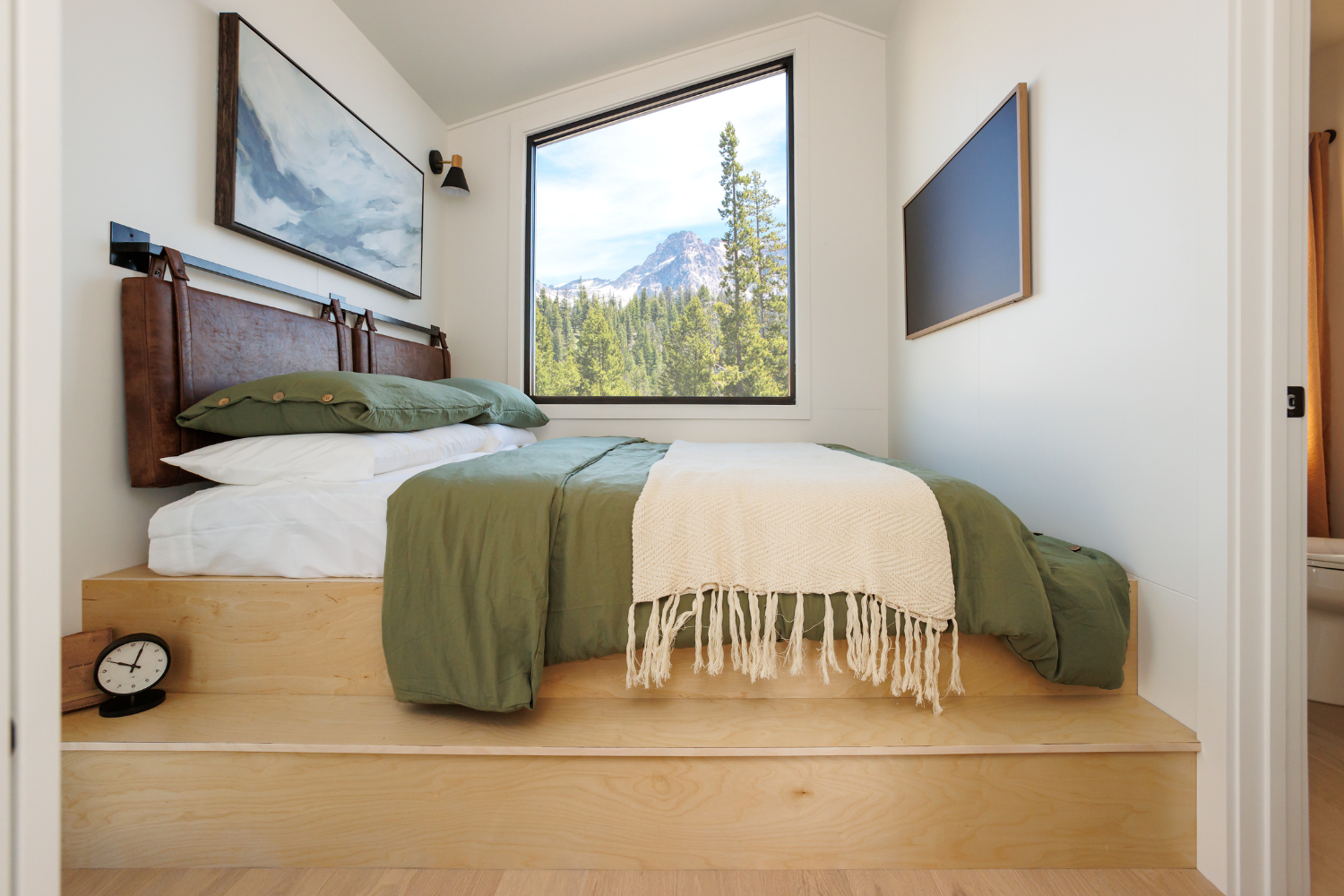
Click On One Of The Cities Below To Learn More About Their Laws & Regulations.
Tiny Homes That Are Allowed in Ohio
In Ohio, the types of tiny homes that are generally allowed are:
- Permanent Tiny Homes are tiny homes that are constructed on a foundation, adhere to local building codes, and are located in specific residential zones. These homes must comply with all safety, zoning, and utility standards. Tiny home regulations in Ohio require these homes to have a minimum floor area of 950 sq ft, but some counties within Ohio have smaller requirements.
- Tiny Homes on Wheels (THOWs) are tiny houses built on a trailer with wheels, are often considered recreational vehicles (RVs), and are commonly allowed in RV parks, campgrounds, or specific zoning areas that permit RV living. THOWs are also usually referred to as park models.
- Accessory Dwelling Units (ADUs) and Auxiliary Dwelling Units are not permitted as residences in every county in Ohio. However, in some counties and cities, they are legal. ADUs refer to additional dwelling areas on the same property as a primary residence. They can be attached to the primary dwelling or separate from the primary dwelling, and some county codes even refer to internal ADUs.
View our Ohio park model home styles here!
Park Model Regulations in Ohio
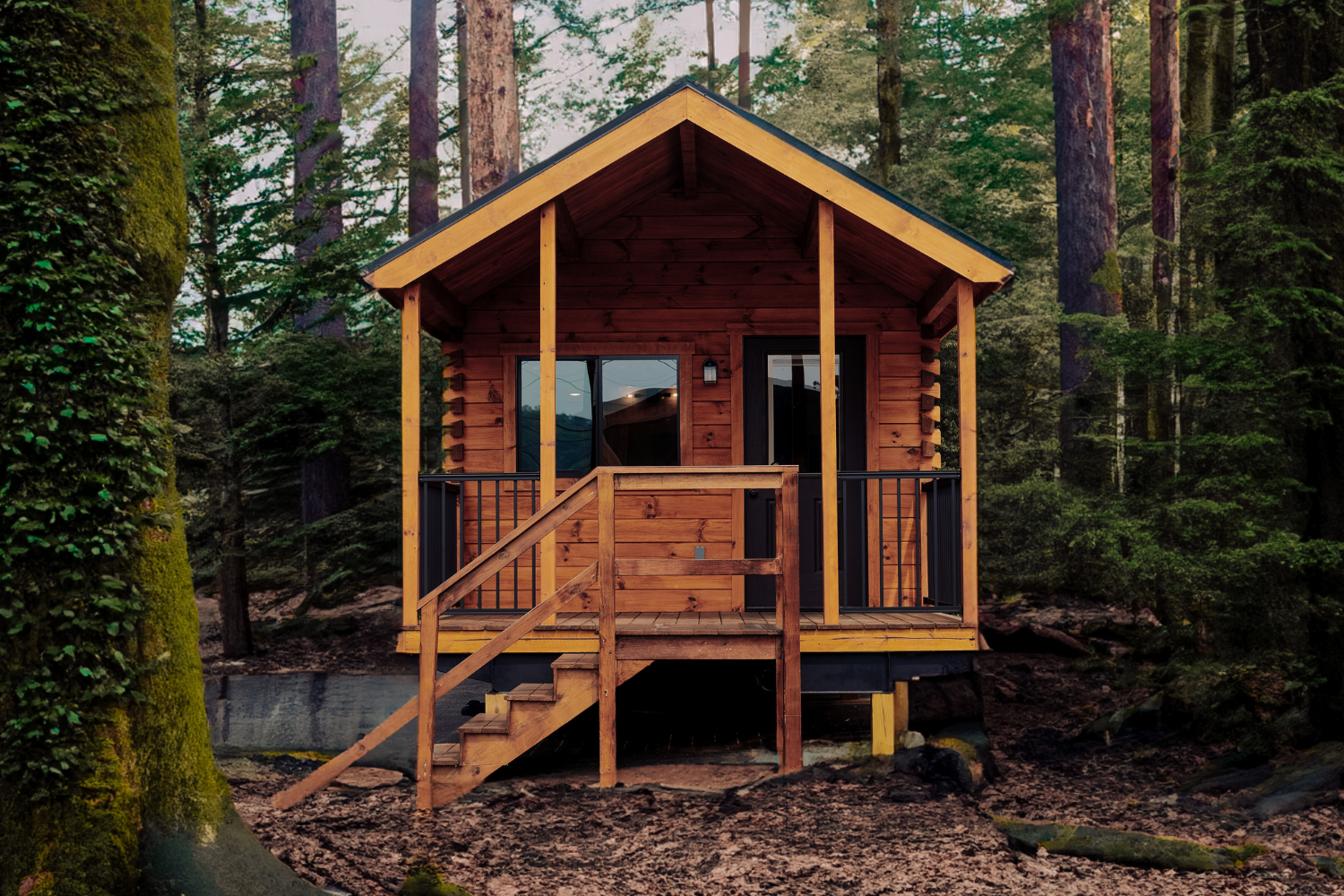
In Ohio, a park model is a recreational vehicle, or RV, that meets the national standard for park trailers. Park models in Ohio must be built on a single chassis, have a total trailer area of no greater than 400 sq ft, and be used for temporary residences. In most counties in Ohio, our park model homes would be classified as recreational vehicles. These models are allowed in some form, usually inside recreational vehicle parks, in most counties in Ohio. Always double-check your local county’s regulations before you buy a tiny house in Ohio.
Read more about park models here!
What are the Rules for Tiny Homes in Ohio?
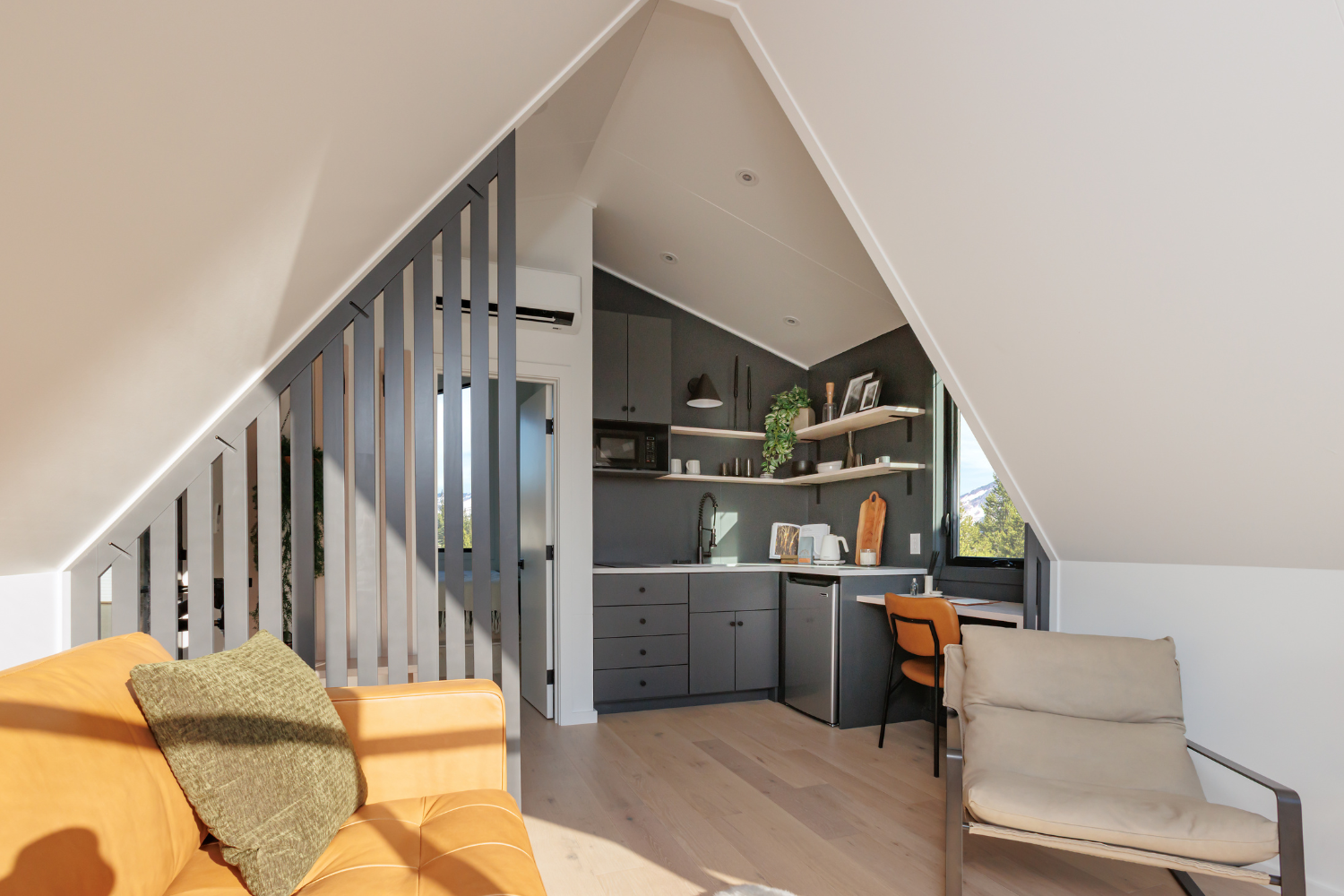
Tiny homes are legal in the state of Ohio. However, there is no specific statewide building law for tiny homes. According to state code, permanent residences must have a minimum of 950 sq ft. This is much larger than most tiny homes. The good news is that many counties in Ohio have different floor area requirements and regulations allowing you to enjoy modern tiny living in Ohio!
Additionally, most tiny homes and park models are allowed in Ohio’s recreational vehicle (RV) parks. Tiny home regulations in Ohio vary from county to county and even from city to town. It is always a good idea to check your local zoning office before building or placing your tiny home.
Do you Need a Permit for a Tiny Home in OH?
In general, most counties and cities in Ohio require a permit for building and placing a tiny home, accessory building, park model home, or a tiny home on wheels. Specific permit requirements will vary based on structure and local laws. It is important to check with local zoning or building departments to learn if you need a permit, how you obtain one, and how much it will cost. You may need a permit to build a tiny house on your current property in the counties where accessory buildings are allowed. Always double-check your local building rules!
Are There Tiny Home Communities in Ohio?
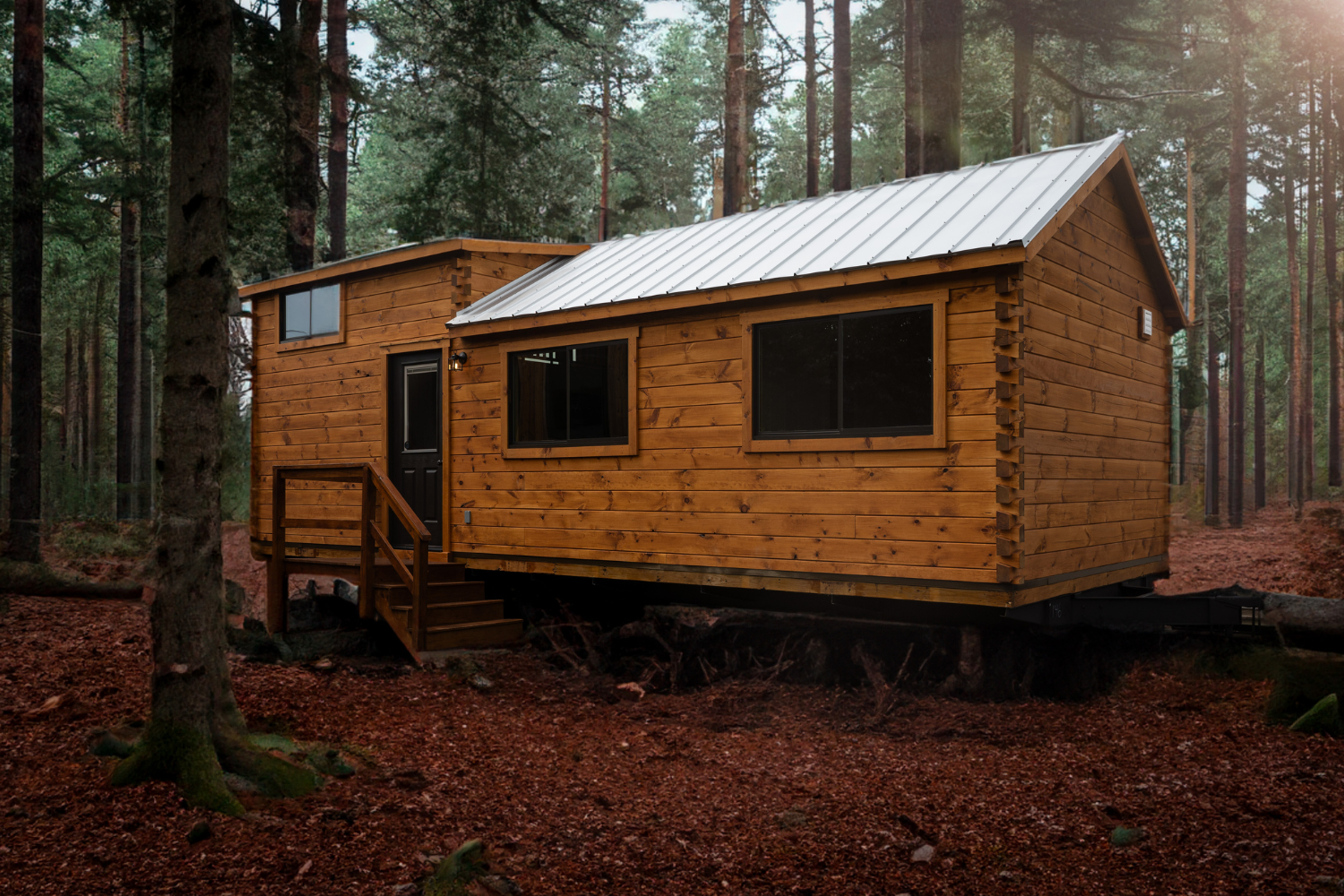
Yes! There are a handful of tiny house communities in Ohio. Living in or visiting a tiny home community in Ohio can be a fantastic way to experience modern tiny living in Ohio. Tiny house communities provide several benefits, including additional amenities and support. Plus, tiny home communities tend to be more affordable to live in than a city, and they are often more eco-friendly.
Cedar Springs Tiny Villages, 300 Cedar Springs Rd, New Paris, OH: The Cedar Springs community is a beautiful tiny home community surrounded by the great outdoors and located less than 2 hours from Cincinnati, Columbus, and Indianapolis. The community offers lakefront views, gorgeous walking paths, access to a community garden, a recycling program, private parking, and water, sewage, and power amenities.
Bluff Street Village, 3613 Monroe St, Toledo, OH: Bluff Street Village is a tiny home project that aims to provide high-quality housing for people with an annual income of less than $18,000. Composed of 20 tiny homes, this neighborhood seeks to revitalize Toledo and create a flourishing neighborhood.
Hocking Hills Tiny Houses, Logan, OH: Hocking Hills Tiny Houses is a wonderful place to experience tiny living in Ohio. Less than an hour from Columbus, Ohio, and amidst Hocking Hills parks, try out tiny living for yourself in this tiny house experience!
Black Diamond Tiny Home Village, Shawnee, OH: The Black Diamond Tiny Home Community is located on Diamond Lake in historic Shawnee, Ohio. The community offers a beautiful location for your tiny home, as well as community activities and seasonal events.
Ohio Tiny Home FAQs
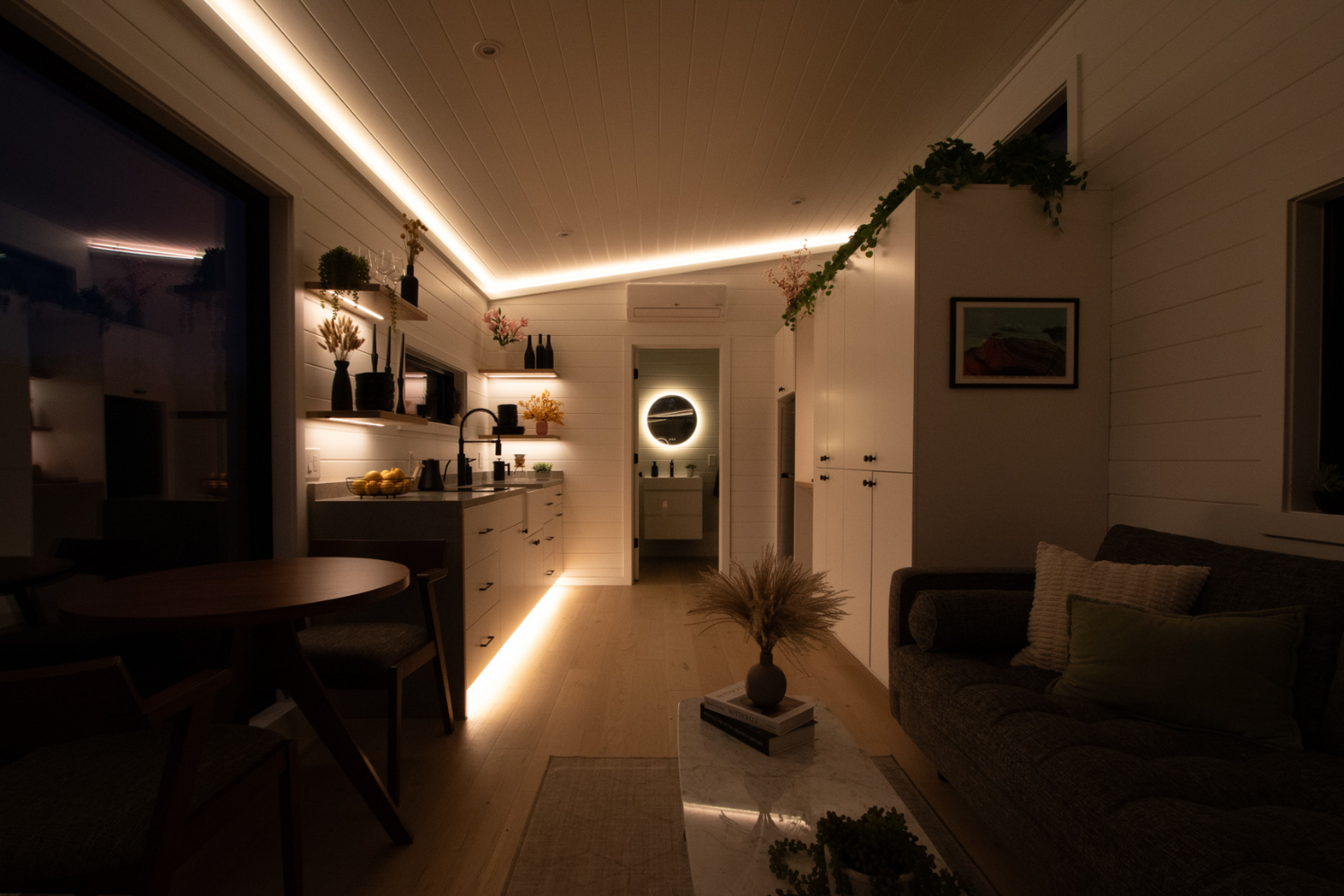
How Much Does it Cost to Build a Tiny House in Ohio?
The average cost of a tiny home in Ohio can be between $30,000-$60,000. Depending on the location, size, and chosen amenities, the total cost can be more or less. Check local tiny homes for sale in your area of Ohio to gauge a realistic price. However, it is usually cheaper to build a tiny house. If you are looking for more in-depth pricing options, check out this article, which offers a cost breakdown of one of our park model homes! Or, contact Zook Cabins to request a free quote on a tiny home today!
Can A Park Model Tiny Home Have Multiple Bedrooms and Bathrooms?
Yes! Park model tiny homes come in a variety of styles and floorplans. They are also often customizable. Check out our current park model options. These styles include floor plans with multiple bedrooms!
What Features Are Included In A Park Model Home From Zook Cabins?
Our park model homes come with a variety of features. Depending on the model or size you choose, these include RVIA Seal, Pella Impervia series Fiberglass windows, Custom Birch cabinets, complete wiring, plumping and insulating, luxury flooring, and more!
Check out our current park model homes here!
Check out this article to see how you can maximize the features of your Zook Cabins park model home!
Discover Our Unique Park Model Homes In Ohio
Customization:
From 10 selections to choose from, you’ll find one that catches your eye. Get to design your home, from floor plans to interior design. You have the freedom to create a home that suits your preferences!
Size and Features:
Each of our Park Model Homes ranges from 204 square feet to 400 square feet, providing a cozy and comfortable space
We finish each home with high-quality furnishings, including essentials such as a toilet, faucets, shelving, light fixtures, and more.
Variety of Styles:
Choose from a unique selection of styles; whether it’s a charming rustic home or a more modern & luxurious home, we have it all. You’ll find a Park Model Home that fits your aesthetic preferences.
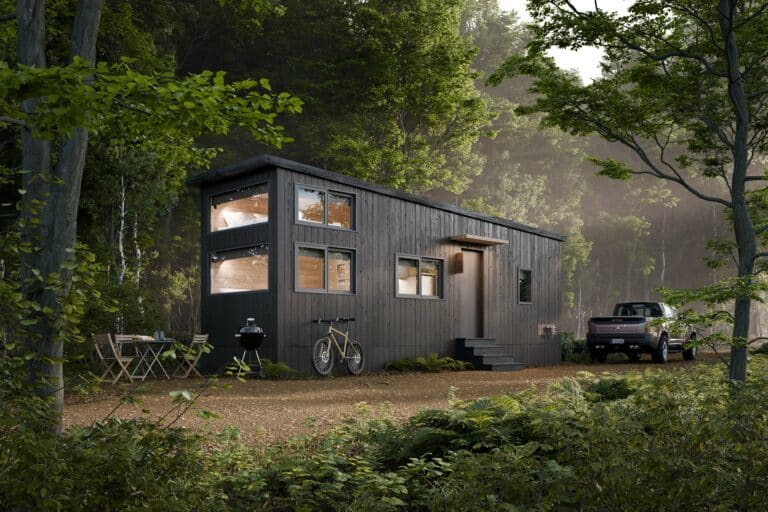
The Nook Family
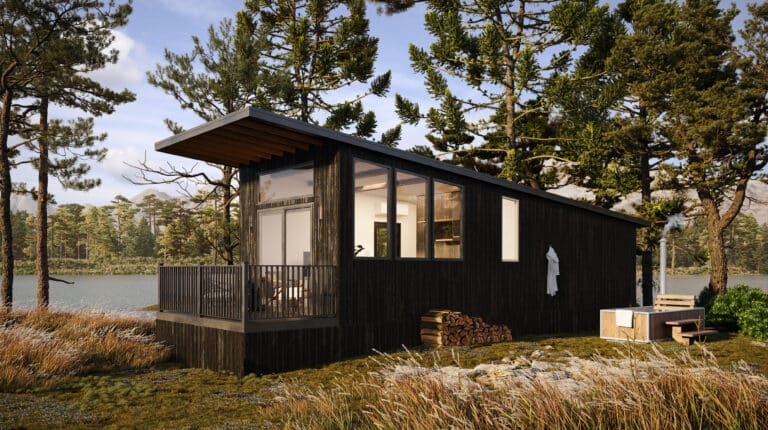
The Rockwood
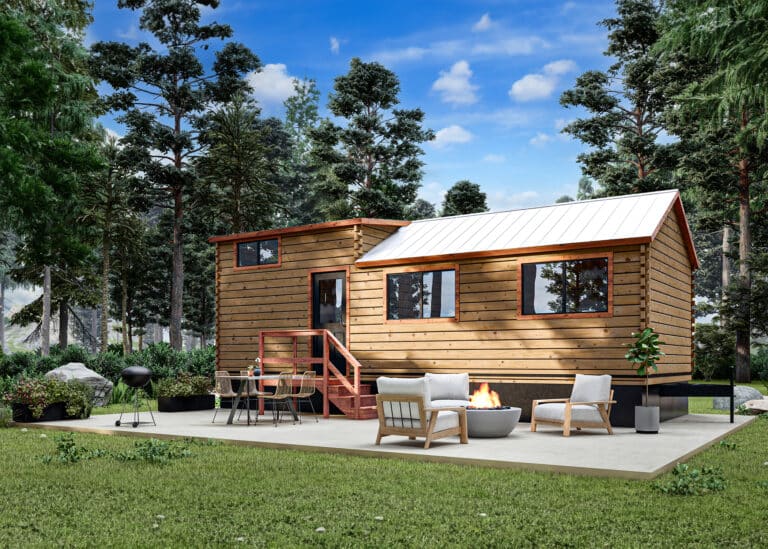
The Pinecrest
Are Granny Pods legal in Ohio?
Granny Pods are legal in some, but not all, parts of Ohio. The use of accessory dwelling units (ADUs), also known as “granny pods” or “in-law suites,” is allowed in many cities in Ohio, including Cincinnati and Dayton. These structures are typically small, self-contained homes on the property of a primary residence. Check local zoning and building codes to determine if a Granny Pod could be allowed on your property.
How Small Does A House Have To Be To Be Considered A Tiny Home?
Tiny homes come in all shapes and sizes! On average, a tiny house is around 225 square feet. However, homes are considered tiny if they are between 100 and 1000 sq ft. Our tiny home models are currently as small as 204 sq ft and as large as 400 sq ft. Ohio has somewhat restrictive regulations for tiny homes, so be sure your area allows your size of tiny home!
What Is The Cheapest Place To Put A Tiny Home In Ohio?
In general, rural areas are less expensive locations than urban areas to place a tiny home in Ohio. Many factors, including location, can affect the cost of your tiny house. Additionally, tiny home communities in Ohio can offer a slightly cheaper place for your tiny home as they frequently offer amenities and have specifically designated the land for tiny home use.
Is There A Minimum Size My Tiny Home Must Be In Ohio?
Yes. Statewide building and residential regulations in Ohio require that permanent residences have a minimum floor area of 950 sq ft. Tiny homes on wheels are classified as recreational vehicles and are not considered permanent residences. However, regulations vary by county, city, and town. To ensure your tiny home meets your local laws, including minimum size requirements, check with your local zoning and building office!
What Would a 950 Sq Ft Tiny Home in Ohio Look Like?
There are many options for building a tiny home in Ohio that is 950 sq ft. Remember that not all counties and cities require permanent structures to be 950 sq ft. Check out Zook Cabins’ other model options to find a home that meets the 950 sq ft minimum floor requirement.
Are There Rent to Own Tiny Home Options in Ohio?
There are a number of financing options for your next tiny home in Ohio. It’s important to consider all your options.
Here is an article from Zook Cabins that explains Home Equity Loans, Refinancing, Sharing a Cabin, Mortgages, and more!
Click here for a free quote on your next tiny home in Ohio!
Are Park Model Tiny Homes A Good Investment?
Yes! Park model tiny homes can absolutely be a good investment. Park models are considered a low-cost investment with a high return on investment, and who wouldn’t want that? Many of our clients have utilized their park model as a short-term rental property or Airbnb and generate additional income from park models. Always check your local regulations to ensure you follow the law for tiny homes and temporary rentals!
If you’re interested in the real estate market, take a look at how Bobby Lee and Andrew converted 11 Park Model houses into their perfect RV camp.
what do other states have to require for tiny living?
Each state has different ideas for what is and isn’t allowed for tiny living. Yet, knowing what the requirements are from state to state can take a lot of time to research. Well, now it doesn’t have to take so long! Check out the table below to see what the requirements are in your state.
